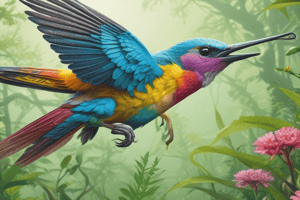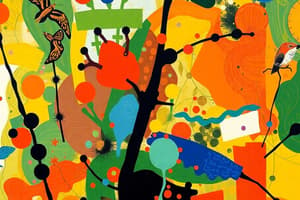Podcast
Questions and Answers
What type of ecosystem in Canada is characterized by black soil and supports various animal species like deer, squirrels, and birds?
What type of ecosystem in Canada is characterized by black soil and supports various animal species like deer, squirrels, and birds?
Grassland
Which type of ecosystem in Canada is dominated by conifers and is well adapted to warm moist summers and cold dry winters?
Which type of ecosystem in Canada is dominated by conifers and is well adapted to warm moist summers and cold dry winters?
Forests - Taiga
Which zone of a lake extends from the lakeshore until the most productive zone and supports caribou?
Which zone of a lake extends from the lakeshore until the most productive zone and supports caribou?
- Littoral zone (correct)
- Profundal zone
- Limnetic zone
Intraspecific competition refers to competition between members of the same species for similar resources.
Intraspecific competition refers to competition between members of the same species for similar resources.
Parasites derive their nourishment from another organism, known as the __________.
Parasites derive their nourishment from another organism, known as the __________.
Define population density and give an example.
Define population density and give an example.
Which domains are single-celled and prokaryotic?
Which domains are single-celled and prokaryotic?
_______ organisms absorb food and do not photosynthesize.
_______ organisms absorb food and do not photosynthesize.
Match the kingdom with its description:
Match the kingdom with its description:
Elk and wolves have overlapping ranges and habitats but have overlapping niches.
Elk and wolves have overlapping ranges and habitats but have overlapping niches.
Flashcards are hidden until you start studying
Study Notes
Ecosystems and Environment
- Environment: everything that affects an organism as well as what that organism affects throughout its life.
- Biotic factors: living things that an organism encounters (e.g., deer, coyote, grass, mice, grasshoppers, hawk).
- Abiotic factors: non-living components that affect the distribution of organisms (e.g., temperature, light, water, soil).
Levels of Organization
- Organism: an individual living thing (e.g., deer).
- Population: a group of individuals of the same species living in a specific area at the same time (e.g., 200 deer in a specific valley).
- Community: all the individuals in all interacting populations in a given area (e.g., deer, coyote, grass, mice, grasshoppers, hawk).
- Ecosystem: a community of populations together with the abiotic factors that affect it (e.g., deer, coyote, grass, mice, grasshoppers, hawk, and the sun, water, and soil).
- Biosphere: all the ecosystems in the world and their interactions.
Classifying and Naming Organisms
- Taxonomy: the system of organizing and classifying organisms.
- Kingdoms: the six major groups of organisms (Archaea, Bacteria, Animalia, Plantae, Fungi, Protista).
- Domains: the three broad categories of life (Archaea, Bacteria, Eukarya).
- Phylum, Class, Order, Family, Genus, Species: the hierarchical system of classification.
- Binomial nomenclature: the system of naming species using a genus and species name (e.g., Canis familiarus - domestic dog).
Studying Organisms in Ecosystems
- Biomes: large regions of the biosphere with specific climate, soil, and vegetation characteristics (e.g., taiga, grassland, deciduous forest).
- Habitat: the specific environment in which a species lives (e.g., forest, grassland, lake).
- Niche: the specific role a species plays in a community and the range of biotic and abiotic requirements it needs to survive.
- Range: the geographical area where a species is found (e.g., the range of the Hoary Marmot).
Major Types of Ecosystems in Canada
- Grassland: characterized by black soil with high productivity, found in the central part of Canada.
- Forests - Taiga: dominated by conifers, found in northern Alberta and the mountains.
- Muskeg (tundra): area of permafrost where the soil never thaws, found in the Arctic.
- Lakes: divided into littoral, limnetic, and profundal zones.
Limiting Factors
- Abiotic limiting factors: soil type, moisture, temperature range, amount of sunlight.
- Biotic limiting factors: predators, parasites, competition (intraspecific and interspecific).
Completing a Field Study
- Types of samples: transects, quadrats.
- Density: the number of individuals per unit volume or area.
Studying That Suits You
Use AI to generate personalized quizzes and flashcards to suit your learning preferences.




